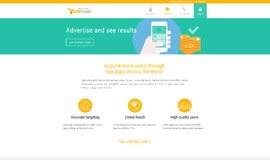The State of Mobile Development For 2016
At the beginning of each year, we’re bombarded by articles that predict mobile development trends. Fearless forecasts that tell us what technological advancements we can expect and what we should prepare for if we want to be ready for the future. Now that two thirds into 2016 and how are these trends working out so far? Which ones are pushing through and which ones are being pushed out?
Javascript Paradigm Shift and Framework Innovations
Cross platform development continues to be a touchy issue with developers. Which is why developers and framework engineers are starting to turn away from the "write once, run anywhere" approach in favor of a "learn once, write anywhere". Instead of forcing frameworks and libraries to bridge almost insurmountable technological differences, the better solution seems to be to redesign the way we use Javascript to allow developers to use the same techniques for web and mobile development.
And nowhere else is this best exemplified than by React Native. It first gained notoriety by eschewing traditional coding conventions, like the separation of logic and UI. But in the end, React Native and similar frameworks like Telerik’s NativeScript has proven that it is possible to speed up the development process by reducing the learning curve needed to develop both web and native apps.
With this concept proven for client-side frameworks, we’re seeing the development of libraries and frameworks to address back end functionalities (Relay) or even cross the client server divide (Meteor).
Increased Competitiveness of Hybrid HTML 5 Apps
Hybrid HTML5 is also becoming an attractive option for mobile developers with the leaps in performance it’s been experiencing in the past few years, the development of native frameworks that support HTML5 like Ionic, and the success of consumer and enterprise applications built with HTML5.
Make no mistake, the quality of hybrid apps still aren’t equal to that of native apps. But we’re starting to see the quality gap close rapidly.
The Citizen Developer Movement and Democratization of Mobile App Development
In the past few years, we saw a massive proliferation of applications and tools that lead to the rise of citizen developers. Almost all the companies and start-ups that offered these tools claim to “democratize” the mobile app development process. They battled over versatility, functionality, and ease of use. And what started out as consumer apps are turning into enterprise suites to help companies and start-ups address the shortage of IT talent.
But in the reviews on different citizen developer platforms, we see that these platforms still aren’t enough to address the need for apps to be customized according to client specifications. Modification and the creation of new features still requires skills, and this is something that the platforms are trying to sell as an added service.
But with the latest offering of citizen developer tools like PowerApps from Microsoft and Project Eve, and the proliferation of coding teaching tools, we’re expecting to see a generation of citizen developers with enough technical skill to fully use these tools to their maximum potential. Along with this, expect to see the development of more powerful non-coding platforms that will be useful for enterprise.
Bigger and better Swift
Since it was introduced in 2014, Swift has taken mobile development by storm. With the integration of Swift for Vine and Linkedin, more mobile apps are being built using Swift, and with the introduction of Perfect for server side management, Swift has grown into a complete package in the span of a only few years. With more teaching guides, improved support, and continued innovation from the Apple team, we expect this language to be a mainstay for years to come.
Wearable Technology and the Internet of Things
Every year the Internet of Things (IoT) and wearable technology is on everybody’s trend list and there’s a perfectly good reason for that. With $19 Trillion Value at Stake, this market has huge potential. We’re seeing the technology mature from being a novelty to becoming an indispensable part of everyday life. It’s already happening with the development of frameworks, libraries and platforms to integrate mobile apps seamlessly with wearable technology and address the issues of big data visualization and processing. The challenge for companies now would be how to organize and analyze this data to drive innovation to where consumers would want to go. If done well, we’ll see more hits in the wearable tech market in the future instead of misses.
The catch though is that most of IoT and wearable technology is still concentrated in the US and Europe. Emerging markets still have numerous technological limitations that need to be addressed. How and when these issues would be addressed could influence how fast, how far, and how deeply ingrained IoT and wearable tech can be implemented globally.
Prioritization of Security and Data Privacy
With cloud storage becoming a standard in application development, widespread use of wearable technology and IoT, security and data privacy will become bigger issues in the coming years. Whether we like it or not, increasing dependence on 3rd party tools and services during app development does introduce a security risk. Sharing data with affiliates and partners for added features, services and content blurs the line on data privacy.
This year alone, Facebook and Google introduced sweeping changes that would give advertisers more access to user information for advertising and content curation. Also early this year Facebook was under fire for manipulating feeds that featured political content. Going into 2017, we expect an increased demand for better data privacy and security, improved user terms on data privacy, and using security and privacy as a unique selling point for enterprise and consumer applications.
The Normalization of M-commerce
With e-commerce and app monetization becoming a standard part of the mobile app development process, m-commerce for consumer mobile applications is becoming more of a standard. What’s driving this trend into becoming a standard is that m-commerce has made it easier, even intuitive, for users to pay for what they want and need through the app—whether it’s for an ebook, access to exclusive features or donating to a crowdsourcing fund. But as m-commerce grows, we expect to see security and privacy issues around it grow. M-commerce breaches and crimes that occur in the future would be the tech scandal to watch out for. To avoid this, developers would have to be proactive in implementing safeguards early on in the development process.
Increased Demand for Enterprise App Developers
It’s becoming clear to developers that promoting paid consumer apps is becoming harder in a marketplace flooded with free apps. Introducing a monetization scheme once your application has reached a critical mass of users can sometimes backfire. We’re starting to see a growing trend of developers creating free consumer apps as part of their portfolio to break into enterprise app development.
Business and companies are willing to pay a premium for talented developers plus the support and infrastructure to actually launch apps in a competitive marketplace. And considering that almost half of enterprise app developers make more than $10,000 per month compared to 19% of consumer app developers, it’s clear where most of the talent is expected to go.
And with the best talent going to enterprise development, we can expect more technological innovations in the coming years from enterprise apps. But would this mean that the free consumer app market would eventually be flooded with mediocre apps? It’s already happening. Not only that, we expect a continuing trend of paid apps being bought out by enterprise apps and being included in their suite. Mainly because it makes sense to work with proven talent and to invest in an app that has already proven to have a solid business model.
Content Is Still King
We’d all like to think that cutting edge features are enough to keep users enthralled but 2016 has shown us that in most instances, quality content matters. A lot. Specifically, quality content that engages and educates the user, and contextualizes the experience.
Without good content, launching a mobile application is like handing a first time driver the keys to a sports car. They know it’s a great car, but they don’t have the knowledge and the skill to fully appreciate what it can do. So investing in quality multimedia content development that highlights your apps capability will become just as important as the mobile app development process itself.
Conclusion
For the most part, we can see that the mobile development trends that continued to push through are mainly consumer driven. The increasing demand for high quality mobile applications despite the talent deficit has pushed for innovations in coding and platform development. The need for intuitive user engagement is driving the development of wearable technology, content development and m-commerce.
But we can also see that the industry is starting to feel the need to create sustainable business structures in order to continue to thrive. We can expect to see enterprise apps testing the waters in the consumer market with innovative monetization strategies to try to make it a stable customer base. We also expect to see more innovations from corporations to address the technological gaps in emerging markets as the US and European markets becomes saturated with start-ups.
Recent Stories
Top DiscoverSDK Experts


Compare Products
Select up to three two products to compare by clicking on the compare icon () of each product.
{{compareToolModel.Error}}

















{{CommentsModel.TotalCount}} Comments
Your Comment